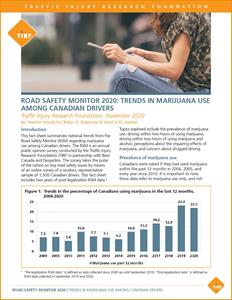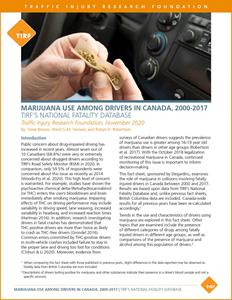Marijuana use by drivers behind the wheel must remain a top road safety priority
OTTAWA, Nov. 26, 2020 (GLOBE NEWSWIRE) -- The Traffic Injury Research Foundation (TIRF) announces the release of two new fact sheets on drivers’ use of marijuana on Canadian roads. National trends are summarized in TIRF’s Road Safety Monitor 2020: Trends in Marijuana Use Among Canadian Drivers. The Road Safety Monitor (RSM) is an annual public opinion poll conducted by TIRF and co-sponsored by Beer Canada and Desjardins. The increasing presence of marijuana among drivers killed in road crashes, even prior to legalization, is reported in the second fact sheet, Marijuana Use Among Drivers in Canada, 2000-2017, also sponsored by Desjardins.
According to RSM data, driving within two hours of using marijuana remains problematic as shown in the level of public concern two years post-legalization in Canada. While more drivers continue to use marijuana behind the wheel since 2018, fewer drivers did so in 2020 as compared to 2019. Results showed 4.5% of drivers (almost 1.2 million) admitted to driving within two hours of using recreational marijuana in 2020. Although this was a decline compared to 7% in 2019, it was still higher than 3.3% in 2018.
“A 36.4% increase in the number of drivers who admitted to driving within two hours of using marijuana suggests the risks associated with this behaviour are not well-understood, and misperceptions about drugged driving persist,” explains Dr. Heather Woods-Fry, TIRF Research Scientist. “The decline since 2019 may indicate education and enforcement initiatives are having an effect on driver behaviour, but clearly some continue to make choices that create risk for all road users.”
In line with these results, public concern has also increased. Unease about drug-impaired driving has risen significantly since 2014, more than five years prior to the legalization of recreational marijuana. Although concern about drugged driving dipped slightly in 2020, (68.8% or nearly seven out of 10 drivers) compared to 2018 (70.3%), many Canadians continue to view this as a priority road safety problem.
Trends among drivers killed in road crashes who tested positive for marijuana between 2012 and 2017 reveals this concern is warranted. During this period, the percentage of fatally injured drivers in Canada who tested positive for marijuana generally increased from 17.2% to 20.5%. This demonstrates combining marijuana use with driving increases crash risk and this is also evident in research studies around the world.
“In recent years, marijuana use among fatally injured drivers has generally increased across all age groups; however, the largest percentage of these drivers were aged 16-19 and 20-34 years,” says Dr. Ward Vanlaar, Chief Operating Officer of TIRF. “The increasing trend in the percentage of fatally injured drivers testing positive for marijuana is concerning, especially considering the combination with alcohol, which is quite common.” In these instances, the non-use of safety equipment by drivers using marijuana or alcohol further increases the likelihood drivers will not survive a crash.
In addition, driver sex explains differences in the magnitude of marijuana use among drivers killed on the road. Fatally injured male drivers were almost twice as likely to test positive for marijuana than female drivers, and trends since 2014 show increases in the percentage of fatally injured male drivers testing positive for marijuana while the percentage of female drivers testing positive has declined. Continued scrutiny is needed as this may suggest male drivers are more willing to drive after using marijuana than female drivers.
The prevalence of self-reported marijuana use by drivers and polysubstance use among drivers killed in road crashes in the past decade indicates more work is needed to raise awareness about the risks of drugged driving. The continued tracking of indicators regarding both substances, and their combined use, remains a top priority.
Download fact sheets in English and French:
- Road Safety Monitor 2020: Trends in Marijuana Use Among Canadian Drivers
- Sondage sur la sécurité routière 2020 : Tendances de la consommation de marijuana chez les conducteurs Canadiens
- Marijuana Use Among Drivers in Canada, 2000-2017
- La consommation de marijuana chez les conducteurs au Canada, 2000 à 2017
About the Traffic Injury Research Foundation:
The mission of the Traffic Injury Research Foundation (TIRF) is to reduce traffic-related deaths and injuries. TIRF is an independent, charitable road safety research institute. Since its inception in 1964, TIRF has become internationally recognized for its accomplishments in identifying the causes of road crashes and developing programs and policies to address them effectively.
About the poll:
These results are based on the RSM, an annual public opinion poll developed and conducted by TIRF. A total of 1,500 Canadians completed the poll in September 2020. Results can be considered accurate within plus or minus 2.5%, 19 times out of 20. The majority of the questions were answered using a scale from one to six where six indicated high agreement, concern, or support and one indicated low agreement, concern or support.
For more information, please contact:
Karen Bowman
Director, Marketing and Communications
Traffic Injury Research Foundation
250-797-0833 (cell)
613-238-5235 (office)
1-877-238-5235 (toll-free)
tirf@tirf.ca
Photos accompanying this announcement are available at
https://www.globenewswire.com/NewsRoom/AttachmentNg/6e4e72d2-c1ff-4255-8c73-2b10379ae523
https://www.globenewswire.com/NewsRoom/AttachmentNg/f909baa6-ae8a-4d98-b1f4-fb4c216ed189




